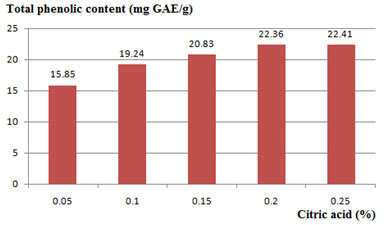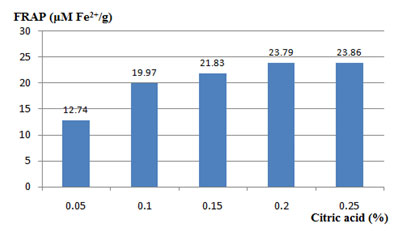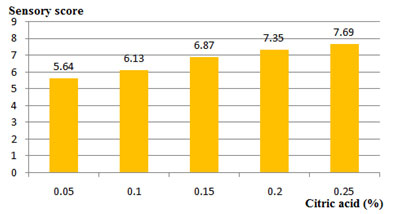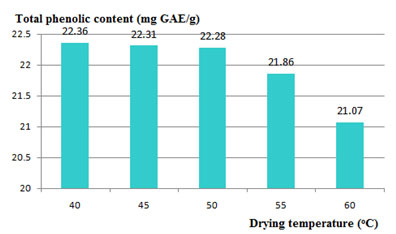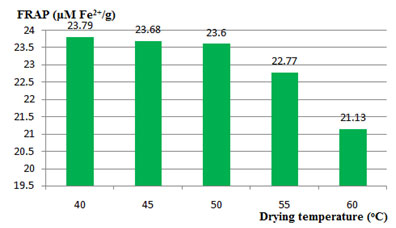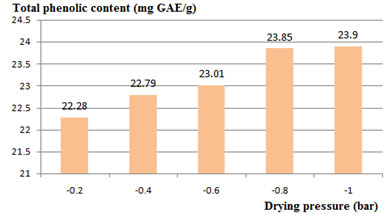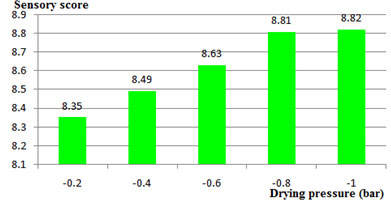Faculty of Biotechnology, Ho Chi Minh City Open University, Ho Chi Minh City, Vietnam
Corresponding author email: minh.np@ou.edu.vn
Article Publishing History
Received: 12/04/2020
Accepted After Revision: 23/05/2020
Tea is one of the most popularly consumed beverages worldwide. Pakalana (Telosma cordata Merrill) or Thien Ly flower as a valuable crop in different rural areas of Vietnam. It has a great amount of phytochemical components beneficial for human health. It can be converted into herbal tea like a healthy drink. There is not any literature mentioned to tea processing from the Pakalana (Telosma cordata Merrill) flower. Therefore objective of this study focused on the effect of citric acid concentration (0.05, 0.1, 0.15, 0.2, 0.25%) in blanching; vacuum drying temperature (40oC, 45oC, 50oC, 55, 60oC) and pressure (-0.2, -0.4, -0.6, -0.8, -1.0 bar) to total phenolic content (mg GAE/g), antioxidant activity (μM Fe2+/g) and organoleptic attribute (sensory score) of the dried pakalana flower tea. Results showed that pakalana flower should be blanched in hot water 95oC at 5 seconds in the present of citric acid 0.2% and then being dried by vacuum dryer at 50oC, -0.8 bar for 6 hours to get the final moisture content below 10.0% available for preservation. Pakalana flower could be utilized as an appropriate material for processing one kind of functional food.
Pakalana flower, blanching, vacuum drying, herbal tea, total phenolic, antioxidant activity
Nguyen M. P. Investigations on the Processing and Production of Herbal Tea from Pakalana Telosma cordata, Fowers using Blanching and Drying. Biosc.Biotech.Res.Comm. 2020;13(2).
Nguyen M. P. Investigations on the Processing and Production of Herbal Tea from Pakalana Telosma cordata, Fowers using Blanching and Drying. Biosc.Biotech.Res.Comm. 2020;13(2). Available from: https://bit.ly/35nb4P5
Copyright © Nguyen This is an open access article distributed under the terms of the Creative Commons Attribution License (CC-BY) https://creativecommns.org/licenses/by/4.0/, which permits unrestricted use distribution and reproduction in any medium, provide the original author and source are credited.
INTRODUCTION
The genus Telosma includes three species, Telosma cordata, T. pallida and T. puberula (Michele and Manop, 2019). Telosma cordata or Thien ly is grown as a valuable crop in different rural areas of Vietnam. It is a perennial vine propagating from rooted stem cuttings and growing on trellises of various kinds (Dau et al., 2008). Pakalana (Telosma cordata Merrill) flower was cultivated as floral fragrance plant (Widodo, 2014). The flowers are very fragrant, peduncle 0.5-1.5 cm, puberulent (Shakun and Shivani, 2019). This plant was popular for its flower as vegetable with great antimicrobial property (Krasaekoopt and Kongkarnchanatip, 2005). The leaves are good source of essential oils as well as exhibit many medicinal properties for ailments such as wound, scaby, ulcer, headache. Flower buds have normally been consumed stir-fried or boiled. They were used in cooking and medicinally to treat conjunctivitis. At 21oC and 24oC, inflorescence initiation of pakalana flower occured after 3 weeks and the clusters grew to 6 mm in another 2 weeks (Criley 1995). Geraniol, beta-ionone, dihydro-beta-ionone, dihydro-beta-ionol, and cis-and trans-theaspirane were major volatile components of Pakalana (Telosma cordata Merrill) flower (Arai et al., 1993). Extract of pakalana (Telosma cordata Merrill) flower has a great antidiabetic potential (Lilibeth and Edna, 2014).
Edible flowers have valuable phytochemical constituents with abundant antioxidant activities. Phenolics are a substantial and diverse group of phytochemicals (Ngoitaku et al., 2016). Phenolics are responsible for antioxidant characteristics related to their capabilities to scavenge free radicals, break radical chain reactions and chelate metals. They are correlated with a reduced risk of cardiovascular disease and cancers (Huang et al., 2010). Herbal teas are infusions made from fruits, leaves, flowers, roots and stems of plants and are intended for oral aqueous consumption (Malongane et al., 2018). Herbal teas contribute extremely strong taste, relaxation, rejuvenation with different therapeutic and energizing benefits (Chandini, 2014; Joubert et al., 2017; Florence et al., 2020; Quang and Hoang, 2020).
Production of tea has been broadly investigated on variety of materials such as chamomile, ginger, ginseng, peppermint, cinnamon, roselle etc. However, the research on production of edible flower tea from pakalana flower has been rarely reported. Therefore purpose of this study focused on the citric acid concentration in blanching and vacuum drying temperature and pressure to total maintain the phenolic content, antioxidant capacity and organoleptic property of pakalana flower, to be used as tea a popular functional herbal drink.
MATERIAL AND METHODS
Pakalana (Telosma cordata Merrill) flowers were collected from Soc Trang province, Vietnam. After collecting, they must be quickly conveyed to laboratory for experiments. The fresh edible flowers were cleaned under tap water to remove foreign matters; the petals were separated and kept at room temperature to drain. Petals were blanched and dried under different conditions. Chemical substances and reagents such as Folin-Ciocalteu reagent, sodium carbonate, gallic acid standard, acetate buffer, TPTZ , HCl, FeCl. 6H2O were all analytical grade supplied from Rainbow Trading Co. Ltd., Vietnam.
Effect of citric acid concentration in blanching to total phenolic content (mg GAE/g), antioxidant activity (μM Fe2+/g) and organoleptic attribute (sensory score) in the dried pakalana (Telosma cordata Merrill) flower tea: Raw pakalana (Telosma cordata Merrill) flowers were blanched in citric acid solution (0.05, 0.1, 0.15, 0.2, 0.25%) at 95oC, 5 seconds. Then they were dripped and dried by vacuum dryer at 40oC, -0.2 bar for 6 hours by vacuum dryer. Then they were analyzed total phenolic content (mg GAE/g), antioxidant activity (μM Fe2+/g), organoleptic attribute (sensory score) to choose the best citric acid concentration in blanching.
Effect of vacuum drying temperature and pressure to total phenolic content (mg GAE/g), antioxidant activity (μM Fe2+/g) and organoleptic attribute (sensory score) in the dried pakalana (Telosma cordata Merrill) flower tea: Raw Pakalana (Telosma cordata Merrill) flowers were blanched in hot water with 0.2% citric acid at 95oC in 5 seconds. Then these samples would be dripped and dried under vacuum dryer at different temperature (40oC, 45oC, 50oC, 55oC, 60oC) and different pressure (-0.2, -0.4, -0.6, -0.8, -1.0 bar) for 6 hours. All samples were analyzed total phenolic content (mg GAE/g), antioxidant activity (μM Fe2+/g), organoleptic attribute (sensory score) to select the optimal drying condition.
Phytochemical, sensory analysis : The total phenolic content (TPC, mg GAE/g) was estimated as gallic acid equivalents by the Folin–Ciocalteu reagent method (Djeridane et al., 2006). An extract of 1 mL from Pakalana was mixed with 5 mL of Folin-Ciocalteu reagent in a test tube and kept at ambient temperature. After 10 min, 4 mL of 7.0% (w/v) Na2CO3 and the mixture was left for reaction at ambient temperature in a dark place for 30 minutes. The absorbance of the reacted mixture was then measured at 765 nm using a spectrophotometer. The total phenolic content of the extracts was expressed as mg gallic acid equivalent (mg GAE) based on the standard curve of gallic acid solutions.
The antioxidant activity (FRAP, μM Fe2+/g) was measured by ferric-reducing antioxidant power (Benzie and Strain, 1996). The FRAP reagent was prepared by mixing acetate buffer (250 mM, pH 3.5), a solution of 10 mM TPTZ in 40 mM HCl, and 20 mM FeCl3 at 10:1:1 (v/v/v). The reagent (3.400 μL) and sample solutions (100 μL) were added to each well and mixed thoroughly. The absorbance was taken at 593 nm after 30 minutes. Organoleptic attribute (sensory score) of pakalana (Telosma cordata Merrill) flower was assessed by a group of 11 panelists using the 9-point Hedonic scale.
Statistical analysis: The experiments were run in triplicate with three different lots of samples. The data were presented as mean±standard deviation. Statistical analysis was performed by the Statgraphics Centurion XVI.
RESULTS AND DISCUSSION
Effect of citric acid concentration in blanching to total phenolic content (mg GAE/g), antioxidant activity (μM Fe2+/g) and organoleptic attribute (sensory score) in the dried pakalana (Telosma cordata Merrill) flower tea: In our reseach, raw pakalana (Telosma cordata Merrill) flowers were blanched in citric acid solution (0.05, 0.1, 0.15, 0.2, 0.25%) at 95oC, 5 seconds. Then they were dripped and dried by vacuum dryer at 40oC, -0.2 bar for 6 hours by vacuum dryer. Then they were analyzed total phenolic content (mg GAE/g), antioxidant activity (μM Fe2+/g), organoleptic attribute (sensory score) to validate the appropriate blanching condition. Results were mentioned in figure 1-3. From figure 1-3, the pakalana (Telosma cordata Merrill) flower should be blanched at 95oC in 5 seconds in the presence of 0.2% citric acid to maintain the most total phenolic content, antioxidant capacity and organoleptic attribute in the dried pakalana (Telosma cordata Merrill) flower tea.
Figure 1: Effect of citric acid concentration (%) in blanching to total phenolic content (mg GAE/g) in the dried pakalana (Telosma cordata Merrill) flower tea
Figure 2: Effect of citric acid concentration (%) in blanching to antioxidant activity (μM Fe2+/g) in the dried pakalana (Telosma cordata Merrill) flower tea
Figure 3: Effect of citric acid concentration (%) in blanching to organoleptic attribute (sensory score) in the dried pakalana (Telosma cordata Merrill) flower tea
Flower is an important part of plant containing natural antioxidants such as phenolic acids, flavonoids, anthocyanin and many other phenolic compounds (Kaur et al., 2006). Phenolic compounds are the most important phytochemicals in pakalana (Telosma cordata Merrill) flower which flavonoids and anthocyanins are the most common groups (Sarepoua et al., 2013). The application of citric acid in the blanching medium resulted in higher total phenolic retention and antioxidant activity than the usage of water only. This result was similar to other findings in blanching white saffron (Pujimulyani et al. 2010), corn (Randhir et al., 2008), wheat (Cheng et al., 2006). It was presumed that in blanching process, the antioxidants in the form of glycoside were hydrolized into aglikon and sugar (Yue and Xu, 2008). The blanching of pakalana flower increased antioxidant activity. Phenolic compounds could breakdown during the blanching. The increased of antioxidant activity in the blanching treatment could be explained due to heating which caused antioxidant compound to be extracted more easily (Pujimulyani et al. 2010).
According to Montinee et al. (2017), the aqueous extract of Telosma flower had the highest total phenolic concentration (991.3 mg GAE/100g). It had the highest activities as a DPPH radical scavenger (252.5 mg/L) and as an inhibitor of lipid peroxidation. For anti-lipid peroxidation, the IC50 (the half-maximal inhibition concentration) value of the aqueous Telosma flower extract was 1539.93 mg/L. Flavonoids are the bioactive phytochemical constituents which make the plant resistant to the attack of microbes, insects and also protect the animals against various diseases (Guevara et al., 2000; Silva et al., 2002; Nessa et al., 2012).
Flavonoids possess strong antioxidant activity and free radical-scavenging capacity and inhibit protein glycation (Silva et al., 2002; Matsuda et al., 2003; Wu et al., 2005). Blanching is one of the most important pre-treatment step in processing of various herbal tea products. The main purpose of blanching is to inactivate enzymes that cause negative effects on the product quality. High temperature in short time blanching is normally prefered to avoid the occurence of degradable reactions during the storage. Unfortunately blanching also creates changes in cellular structure and composition (Vina et al., 2007).
Effect of vacuum drying temperature and pressure to total phenolic content (mg GAE/g), antioxidant activity (μM Fe2+/g) and organoleptic attribute (sensory score) in the dried pakalana (Telosma cordata Merrill) flower tea
In the present research, raw pakalana (Telosma cordata Merrill) flowers were blanched in hot water with 0.2% citric acid at 95oC in 5 seconds. Then these samples would be dried by vacuum dryer at different temperature (40oC, 45oC, 50oC, 55, 60oC) and different pressure (-0.2, -0.4, -0.6, -0.8, -1.0 bar). All samples were analyzed total phenolic content (mg GAE/g), antioxidant activity (μM Fe2+/g), organoleptic attribute (sensory score) to validate the appropriate drying temperature and pressure. Results were mentioned in figure 4-9. From figure 4-9, the pakalana (Telosma cordata Merrill) flower should be dried at 50oC, -0.8 bar to maintain the most total phenolic content (mg GAE/g), antioxidant activity (μM Fe2+/g) and organoleptic attribute in the dried pakalana (Telosma cordata Merrill) flower tea. These could be explained by faster inactivation of oxidase enzyme (polyphenol oxidase) at higher temperature (Lim and Murtijaya, 2007; Saifullah et al., 2019).
Figure 4: Effect of drying temperature (oC) at -0.2 bar pressure to total phenolic content (mg GAE/g) in the dried pakalana (Telosma cordata Merrill) flower tea
Figure 5: Effect of drying temperature (oC) at -0.2 bar pressure to antioxidant activity (μM Fe2+/g) in the dried pakalana (Telosma cordata Merrill) flower tea
Figure 6: Effect of drying temperature (oC) at -0.2 bar pressure to organoleptic attribute (sensory score) in the dried pakalana (Telosma cordata Merrill) flower tea
Figure 7: Effect of drying pressure (bar) at 50oC to total phenolic content (mg GAE/g) in the dried pakalana (Telosma cordata Merrill) flower tea
Figure 8: Effect of drying pressure (bar) at 50oC to antioxidant activity (μM Fe2+/g) in the dried pakalana (Telosma cordata Merrill) flower tea
Figure 9: Effect of drying pressure (bar) at 50oC to organoleptic attribute (sensory score) in the dried pakalana (Telosma cordata Merrill) flower tea
Total phenolic content loss caused by enzymatic reactions could be minimized by blanching before vacuum drying. Drying is generally identified as a process of water removal and decreasing of herbal moisture content in limiting microbial and enzymatic activity, consequently maintaining product stability (Taha et al., 2015). Vacuum drying is a popular strategy utilized for dehydration of various herbal plants, especially matrices having thermal sensitive components (Methakhup et al., 2005).
In drying period, metabolically active plants lose moisture slowly. Polyphenol oxidases are not able to degrade phenolic components in dehydration. Degradation of phytochemicals could be related to thermal process only (Ismail et al., 2004). Drying process resulted in a depletion of naturally occurring antioxidants was mentioned in raw plant materials (Tomaino et al., 2005). Thermal process might create significant loss in antioxidants, deactivate enzymes and degrade phytochemicals (Taha et al., 2015). Volatile compounds are key contributors to herbal tea flavour (Gong et al., 2017). The drying at 80 ◦C produced the dried Roselle with the highest retention of total phenolic content (Quang and Hoang, 2020).
CONCLUSION
Pakalana flower has attracted a great attention due to a variety of its bioactive phytochemical constituents. In this reseach, we have successfully investigated some major technical parameters of citric acid concentration in blanching and vacuum drying conditions influencing to processing of pakalana (Telosma cordata Merrill) flower into herbal tea. Phenolic component and antioxidant capacity could be stronly affected during the blanching and drying. Diversification of valuable pakalana (Telosma cordata Merrill) flower into healthy herbal tea could enhance its agricultural commercial value.
REFERENCES
Arai T, Hashimoto S, Furukawa K (1993). Volatile components of Telosma cordata Merrill flowers. Flavour and Fragrance Journal 8: 221-223.
Benzie IF and Strain JJ (1996). The ferric reducing ability of plasma (FRAP) as a measure of antioxidant power: The FRAP assay. Analytical Biochemistry 239: 70-76.
Chandini R (2014). Review on herbal teas. Journal of Pharmaceutical Sciences and Research 6: 236-238.
Cheng Z, Su L, Moore J, Zhou K, Luther M, Yin J and Yu L (2006). Effects of post harvest treatment and heat stress on availability of wheat antioxidants. Journal of Agriculture and Food Chemistry 54: 5623- 5629.
Criley RA (1995). Temperature influences flowering of pakalana (Telosma cordata Merrill) under long days. HortScience 30: 482-483.
Dau VT, Tran CV, Pham LT, Phan HT, Dang HL, Burgess LW (2008). Stem and root rot of Telosma cordata caused by Phytophthora palmivora in Vietnam – a newly recognized disease. Australasian Plant Disease Notes 3: 135–137.
Djeridane A, Yousfi M, Nadjemi B, Boutassouna D, Stocke P, Vidal N (2006). Antioxidant activity of some Algerian medicinal plants extracts containing phenolic compounds. Food Chemistry 97: 654-660.
Florence M, Lyndy JM, Legesse KD, Fhatuwani NM (2020). Sensory characteristics and volatile compounds of herbal teas and mixtures of bush tea with other selected herbal teas of South Africa. Foods 9: 496.
Gong X, Han Y, Zhu J, Hong L, Zhu D, Liu J, Zhang X, Niu Y, Xiao Z (2017). Identification of the aroma-active compounds in Longjing tea characterized by odor activity value, gas chromatographyolfactometry, and aroma recombination. Int. J. Food Prop. 20: 1107–1121.
Guevara P, Perez-Amador MC, Zuniga B, Snook M (2000). Flavones in pakalana (Telosma cordata Merrill) flower s & resistance to insect attacks. Phyton 69: 151-156.
Huang WY, Cai YZ, Zhang Y (2010). Natural phenolic compounds from medicinal herbs and dietary plants: potential use for cancer prevention. Nutrition and Cancer 62: 1-20.
Ismail A, Marjan ZM, Foong CW (2004). Total antioxidant activity and phenolic content in selected vegetables. Food Chemistry 87: 581–586.
Joubert E, Beer D, Malherbe CJ (2017). Herbal teas—Exploring untapped potential and strengthening commercialization. S. Afr. J. Bot. 110: 1–3.
Kaur G, Alamb MS, Jabbar Z, Javed K, Athar M (2006). Evaluation of antioxidant activity of Cassia siamea flowers. Journal of Ethnopharmacology 108: 340-348.
Krasaekoopt W and Kongkarnchanatip A (2005). Anti-microbial properties of Thai traditional flower vegetable extracts. AU J.T. 9: 71-74.
Lilibeth AC, Edna AA (2014). Hypoglycemic property of Telosma procumbens (Blanco) Merr. (Apocynaceae) in normal and alloxan-induced diabetic juvenile mice (Mus musculus). The Journal of Phytopharmacology 3: 113-117.
Lim YY, Murtijaya J (2007). Antioxidant properties of Phyllanthus amarus extracts as affected by different drying methods. LWT – Food Science and Technology 40: 1664-1669.
Malongane F, McGaw LJ, Nyoni H, Mudau FN (2018). Metabolic profiling of four South African herbal teas using high resolution liquid chromatography-mass spectrometry and nuclear magnetic resonance. Food Chem. 257: 90–100.
Matsuda H, Wang T, Managi H, Yoshikawa M (2003). Structural requirements of flavonoids for inhibition of protein glycation and radical scavenging activities. Bioorganic and Medicinal Chemistry 11: 5317-5323.
Methakhup S, Chiewchan N, Devahastin S (2005). Effects of drying methods and conditions on drying kinetics and quality of Indian gooseberry flake. LWT – Food Science and Technology 38: 579-587.
Michele R, Manop P (2019).A new species of Telosma (Apocynaceae, Asclepiadoideae) from Thailand. Phytoaxa 416: 238-242.
Montinee T, Kanokporn C, Pilasombut K, Chamroon L (2017). Antioxidant activities and heat stability of edible flowers of Telosma minor and Sesbania javanica. Journal of Herbs Spices and Medicinal Plants 24: 1-12.
Nessa F, Ismail Z, Mohamed N (2012). Antimicrobial activities of extracts and flavonoid glycosides of pakalana (Telosma cordata Merrill) flower (Zea mays L). International Journal of Biotechnology for Wellness Industries 1: 115-120.
Ngoitaku C, Kwannate P, Riangwong K (2016). Total phenolic content and antioxidant activities of edible flower tea products from Thailand. International Food Research Journal 23: 2286-2290.
Pujimulyani D, Raharjo S, Marsono Y and Santoso U (2010). The effects of blanching treatment on the radical scavenging activity of white saffron (Curcuma mangga Val.). International Food Research Journal 17: 615-621.
Quang VN, Hoang VC (2020). Processing of herbal tea from roselle (Hibiscus sabdariffa L.): Effects of drying temperature and brewing conditions on total soluble solid, phenolic content, antioxidant capacity and sensory quality. Beverages 6: 2.
Randhir R, Kwan YI and Shetty K (2008). Effect of thermal processing on phenolics, antioxidant activity and health-relevant functionality of select grain sprouts and seedlings. Innovative Food Science and Emerging Technologies 9: 355-364.
Saifullah, Rebecca C, Adam C, Quan V (2019). Effects of different drying methods on extractable phenolic compounds and antioxidant properties from lemon myrtle dried leaves. Heliyon 5: 03044.
Shakun M, Shivani T (2019). Telosma cordata (Burm.f.) Merr. – a new distributional record for central India, Madhya Pradesh. Accent Journal Of Economics Ecology and Engineering 4: 1-3.
Sarepoua E, Tangwongchai R, Suriharn B, Lertrat K (2013). Relationships between phytochemicals and antioxidant activity in pakalana (Telosma cordata Merrill) flower. International Food Research Journal 20: 2073-2079.
Silva MM, Santos MR, Caroço G, Rocha R, Justino G, Mira L (2002). Structure-antioxidant activity relationships of flavonoids: A re-examination. Free Radical Research 36: 1219-1227.
Taha MR, Muhammad A, Mohammad A, Majdi AM, Khalil E, Juan A, Bayan A, Ali A, Wade Y (2015). Effects of drying process on total phenolics, antioxidant activity and flavonoid contents of common Mediterranean herbs. Int J Agric & Biol Eng 8: 145-150.
Tomaino A, Cimino F, Zimbalatti V, Venuti V, Sulfaro V, De PA (2005). Influence of heating on antioxidant activity and the chemical composition of some spice essential oils. Food Chemistry 89: 549–554.
Vina SZ, Olivera DF, Marani CM, Ferreyra RM, Mugridge A, Chaves AR and Maschereni RH (2007). Quality of brussels sprouts (Brassica oleracea L. gemmifera DC) as affected by blanching method. Journal of Food Engineering 80: 218-225.
Widodo (2014). A Discovery and characteristics description of Telosma puberula (Asclepiadoideae) in mount Gedang Atas and mount Ijo, Baturagung mountain Yogyakarta. Biology, Medicine, and Natural
Product Chemistry 3: 47-52
Wu CH, Yen GC (2005). Inhibitory effect of naturally occurring flavonoids on the formation of advanced glycation endproducts. Journal of Agricultural and Food Chemistry 53: 3167-3173.
Yue X and Xu Z (2008). Changes of anthocyanins, anthocyanidins, antioxidant activity in bilberry extract during dry heating. Journal of Food Science 73: 494- 499.

